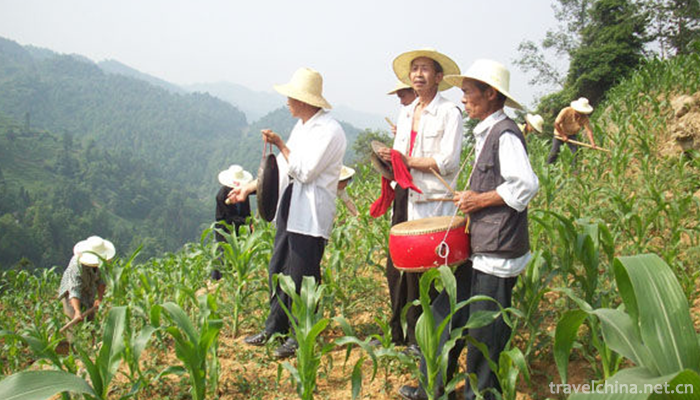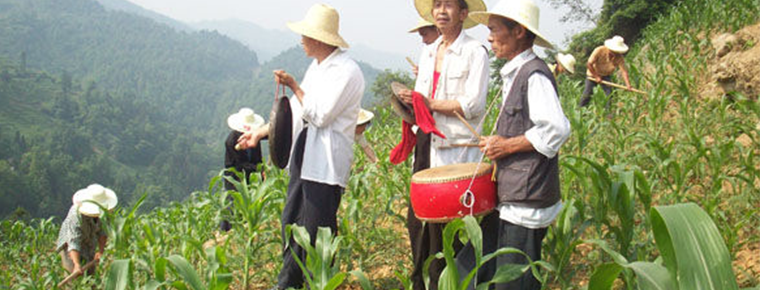Caogao Gong and drum in northern Sichuan
Caogao Gong and drum in northern Sichuan
Licao Gong and drum in northern Sichuan is a kind of traditional folk music. It mainly distributes in four counties and three districts of Guangyuan City, Sichuan Province, among which Qingchuan Grass Drum is the most representative. Grass drum is a kind of traditional folk culture widely spread in the northern mountainous areas of Sichuan Province. It is commonly known as "playing Gong and drum grass", "playing Gong and drum grass", "banishing Gong and drum grass". In July and August of each year, people usually sing a folk song when they weed corn grass and soybean grass together. Grass gongs and drums can not only ensure the progress and quality of weeding, but also make heavy manual labor easy in laughter, so that workers can fully enjoy the pleasure and happiness of labor.
On May 20, 2006, the dragon and drum in northern Sichuan were listed in the first batch of national intangible cultural heritage list with the approval of the State Council.
historical origin
Qingchuan County is located in the northern mountainous areas of Sichuan Basin, the junction of Sichuan, Gansu and Shaanxi provinces, known as the "home of giant pandas". Qingchuan grass gongs and drums are distributed in 36 villages and towns in the county. The grass gongs and drums in Banqiao Township, Daba Township, Qingxi Township, Sanguo Township, Debris Township and Maoba Township are the most distinctive.
artistic characteristics
Rich content
In July and August of each year, when weeding corn grass and soybean grass, several or dozens of households of labor force gather together, one person beats gongs, one person beats drums, while beating rhythmically singing, to inspire the morale of workers, unify the pace, eliminate fatigue. The gongs and drums are mostly local knowledgeable, prestigious old people or young people with cultivation prospects. The gongs are called "song Lang" and the drummers are called "joining hands" and "going the same way".
The process of a day can be roughly divided into: pulling strings, putting a lid (starting or choreographing), Anwufang (or worshipping Wufang), speaking the text, playing songs, and handing over. At about eight o'clock in the morning, when the Gong sounded, people were told that it was time to go out. Gongshou walking in front, the rest of the people heard the sound followed, gradually connected into a line in the mountain path, commonly known as "lead line". Arriving at the farming destination, the singer begins with a song and opens with a high-pitched voice in the accompaniment of gongs and drums. Next is "An Wufang". Some singers worship the five gods of east, west, north and south, while others worship heaven, earth and people directly. They pay attention to "time, place, people and people".
It takes up most of the day's work to speak the text. The content of the lyrics includes not only the compiled albums, but also the seven-character or cross written in a fixed format, which is spread orally among the people. In the special red age, Mao Zedong's seven laws and seven unique poems, Guo Moruo's seven-character poems have become the main content of the lyrics. In labor, if someone is found to be behind the times, the singer will come behind him and beat the gong and drum vigorously, encouraging and urging the outdated to catch up. The singer sings loudly and passionately, the laborer weeds quickly, and you chase after me, presenting a lively scene of drum music, song and laughter. Grass gongs and drums can not only ensure the progress and quality of weeding, but also make heavy manual labor easy in laughter, so that workers can fully enjoy the pleasure and happiness of labor.
Various forms
There are seven, nine, twelve and flower beats in the rhythm of cymbals and drums. Melodies and lyrics are divided into seven-character notation and cross notation according to the number of words. In addition, there are many kinds of tunes such as five-character notation and traditional lyrics and improvisational lyrics imparted orally. Singing works mainly include "Han Xiangzhuan", "Eight Immortals Tu", "Nautilus" and "Qingguantu", as well as some folk songs such as "Two-sided Willow Leaves" and "March Baicao Qing".
North Sichuan is rich in content, honest and plain singing and playing methods, with a long history of inheritance, and more than 10,000 oral lyrics. Its tunes are concise and lively, unique and highly appealing, which greatly enriches the cultural life of the people in the deep mountains. Protecting and inheriting the grass gongs and drums in northern Sichuan will certainly enrich and improve the Chinese folk music culture.
Representative works
Biography of Han Xiangzhuan, Eight Immortals Tu, Nautilus Ji, Qingguantu, etc.
Inheritance significance
"Grass Drum in North Sichuan" integrates folk culture and music into hard work. It is the crystallization of the wisdom of the working people in the mountain areas of North Sichuan, and it is also the precious cultural heritage left by the sages of past dynasties. Grass gongs and drums in northern Sichuan are an important part of folk culture in mountain areas of northern Sichuan, and are also excellent folk music culture left over by ancient sages. In the field work, the grass gongs and drums in northern Sichuan play the role of directing labor, activating the atmosphere on the spot and regulating the mood of the laborers. It has a straightforward and simple music personality, rich reserves of thousands of pieces of music, bright and concise vocabulary of music retains a large number of ancient physical labor in the music and cultural information, has a high academic research value.
Nowadays, due to the influence of modern production mode, the traditional production and lifestyle can hardly keep pace with the development of the times. The living space of the grass gongs and drums in northern Sichuan is shrinking day by day, and they are in danger of being lost. Old singers have passed away one after another, young people go out to work, a large number of labor migration, and the singer team is green and yellow. Therefore, the work of protecting and inheriting the grass gongs and drums in northern Sichuan has reached a critical moment.
The state attaches great importance to the protection of intangible cultural heritage. On May 20, 2006, the grass gongs and drums in northern Sichuan were approved by the State Council and listed in the first batch of national intangible cultural heritage lists.


-
1.Pudacuo National Park
Pudacuo National Park, located in the center of the world natural...
Time 2018-10-18 -
2.Central Radio and Television Tower
The Central Radio and Television Tower, now a national 4A scenic spot, is located on the west side of West Third Ring Road, Haidian District, Beijing. Near the Space Bridge, it faces beautiful Yuyuant
Time 2018-12-22 -
3.88 Floor Sightseeing Hall of Jinmao Building
Jinmao Tower's 88th floor sightseeing hall, located in Shanghai, China, has a height of 340.1 meters and an area of 1520 square meters. It is the largest sightseeing hall in China at present. It is th
Time 2019-01-26 -
4.Kuqa Wangfu Scenic Area
Located in Kuqa County, Xinjiang, the "Kuqa Wangfu" was built by Emperor Qianlong of Qing Dynasty in 1759 by dispatching Han craftsmen from the mainland in order to commend the local Uygur l
Time 2019-01-29 -
5.Chao Opera
Chaozhou Opera, known as "Chao Diao", "Chao Yin Opera" and "Bai Zizi Opera", was widely spread in Zhao'an, Yunxiao, Pinghe, Dongshan, Zhangpu and Nanjing of southern Fuji
Time 2019-04-16 -
6.Wind and Fire Meteor
Fenghuo Meteor is a traditional folk performing art which combines acrobatics and martial arts. It is one of the first intangible cultural heritages in Shanxi Province.
Time 2019-04-29 -
7.Music of Confucius Festival in Liuyang Temple
The ancient music of offering sacrifices to Confucius in Liuyang Temple is a traditional folk music in Hunan Province. A list of the second batch of intangible cultural heritage in Hunan Province has
Time 2019-05-14 -
8.Miao Drum and Tibetan Festival
Guzang Festival, also known as the Drum Festival, is a ceremony for the Miao tribe to sacrifice the gods of their ancestors, commonly known as "eating drums and hiding". Guzang Festival exis
Time 2019-06-05 -
9.Zerou
Zerou (Shangyu Zerou), also known as Ashze, is a Tibetan folk dance in Guide County, Qinghai Province. Especially "Shangyu (Chinese: lower row) is soft" is the most important. They often per
Time 2019-07-16 -
10.Liao Song of the Zhuang Nationality
Liao Ge of Zhuang Nationality, folk literature of Pingguo County, Guangxi Zhuang Autonomous Region, is one of the national intangible cultural heritage.
Time 2019-08-16 -
11.Geographical environment of Luzhou
Luzhou City, located in the southeast of Sichuan Province, borders Chongqing and Guizhou Province in the East, Guizhou Province in the south, Yunnan Province, Yibin City and Zigong City in Sichuan Province in the west, Neijiang City and Chongqing City in Sichuan Province in the north.
Time 2020-12-14 -
12.Luzhou Medical and health
By the end of 2018, there were 46 primary health institutions and 39 other health institutions in the city, including 46 primary health institutions and 1 professional health institution. Among the hospitals, there are 97 general hospitals, 15 TCM hospitals and 35 specialized hospitals
Time 2020-12-14